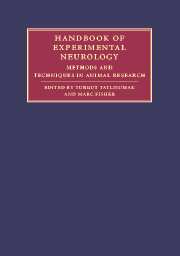Book contents
- Frontmatter
- Contents
- List of contributors
- Part I Principles and general methods
- Part II Experimental models of major neurological diseases
- 18 Focal brain ischemia models in rodents
- 19 Rodent models of global cerebral ischemia
- 20 Rodent models of hemorrhagic stroke
- 21 In vivo models of traumatic brain injury
- 22 Experimental models for the study of CNS tumors
- 23 Experimental models for demyelinating diseases
- 24 Animal models of Parkinson's disease
- 25 Animal models of epilepsy
- 26 Experimental models of hydrocephalus
- 27 Rodent models of experimental bacterial infections in the CNS
- 28 Experimental models of motor neuron disease/amyotrophic lateral sclerosis
- 29 Animal models for sleep disorders
- 30 Experimental models of muscle diseases
- Index
- References
28 - Experimental models of motor neuron disease/amyotrophic lateral sclerosis
Published online by Cambridge University Press: 04 November 2009
- Frontmatter
- Contents
- List of contributors
- Part I Principles and general methods
- Part II Experimental models of major neurological diseases
- 18 Focal brain ischemia models in rodents
- 19 Rodent models of global cerebral ischemia
- 20 Rodent models of hemorrhagic stroke
- 21 In vivo models of traumatic brain injury
- 22 Experimental models for the study of CNS tumors
- 23 Experimental models for demyelinating diseases
- 24 Animal models of Parkinson's disease
- 25 Animal models of epilepsy
- 26 Experimental models of hydrocephalus
- 27 Rodent models of experimental bacterial infections in the CNS
- 28 Experimental models of motor neuron disease/amyotrophic lateral sclerosis
- 29 Animal models for sleep disorders
- 30 Experimental models of muscle diseases
- Index
- References
Summary
Introduction
Amyotrophic lateral sclerosis (ALS) is the most common motor neuron disorder in adults. The disease is characterized by the progressive loss of both upper and lower motoneurons, and is invariably fatal. Symptoms at the beginning of the disease include fatigue, cramps, muscular atrophy, weakness and wasting of one or more limbs or fasciculation of the tongue. As the disease progresses, patients become paralyzed and ultimately die from respiratory failure, typically within 1–3 years after diagnosis. The only medication approved for treatment of ALS is Rilutec® (Riluzole, a glutamate antagonist). However, ALS can currently not be cured and the available therapy offers only limited success, with a life extension of 3–4 months depending on the initiation of treatment. Famous ALS patients, such as the British physicist Stephen Hawking, the US baseball player Lou Gehrig (after whom the disease is named in the US), as well as the recent high incidence of ALS in soccer players especially in Italy have generated an increased public interest into this disease.
The emotional, social, and physical burdens of ALS are evident. Disease management requires sustained effort by patients, their families, caregivers, and healthcare professionals. Further, the economic impact of this disease is enormous. As the diagnosis of ALS is usually reached by exclusion, patients at the beginning of their disease generally undergo a series of arduous tests (magnetic resonance imaging (MRI), electrophysiologic studies, muscle biopsies, and blood studies).
- Type
- Chapter
- Information
- Handbook of Experimental NeurologyMethods and Techniques in Animal Research, pp. 487 - 503Publisher: Cambridge University PressPrint publication year: 2006



